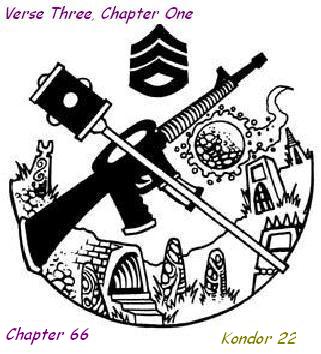
Patreon or PayPal Me keeps this site and its author alive. Thank you. |
Stories from the Verse
Verse Three, Chapter One
Chapter 66: Kondor 22
Table of Contents
Previous chapter: Chapter 65: Hastings 23

Such briefing as Kondor received was confused. First, his hosts assumed he knew everything which was happening, why it was occurring, and how to stop it. Once he convinced them otherwise, he was told a great deal of information by three people at once, most of it laced with superstition about magic and undead creatures. But he was beginning to put the pieces together.
The enemy were either inhuman intelligent creatures of some sort, or humans who had gone to a lot of work to appear otherwise. They were described as half a day's journey away, which he guessed was between ten and fifteen miles. Their staging ground would be clearly marked on the left side of the road, surrounded by an iron bar fence with stone pillars. They preferred to fight at night and sleep in the day, so there would probably be little or no watch on the walls or the gates, and he should be able to enter the grounds from that side undetected. Dimtri, the advisor, insisted that the creatures would not have guards posted by day; Kondor doubted this, but decided he could do his own surveillance when he arrived.
Ahead of him, within a hundred yards or so of the gate, there would be a small building, smaller than any building here at the keep, but the largest within view. Within that building was a small but powerful device, a weapon of some sort which the enemy was using, known as the Vorgo. None of his informers had ever seen it, but they understood it was round and about a foot across, and that it would be sitting on a pedestal in the main room, which he would see clearly as he entered. Kondor speculated that it might be some sort of primitive mortar, a heavy metal or stone pot which fired projectiles by an explosive charge. That made sense to him, but he thought suggesting it would only confuse them.
Although it would be unguarded, he gathered that there was some sort of alarm system on it, because once he took it the enemy would be alerted and would attempt to prevent him from escaping. However, if he could reach the road they would be unlikely to launch any significant immediate pursuit, as they did not often leave their staging ground in the daylight. Thus he should rush back to the keep with it. Once the sun set, the enemy would follow. Given their probable speed, best estimates were that their lead troops would reach the walls about three hours later, their primary infantry an hour after that, and their missile support and toughest warriors two hours later. It was hoped that he would help the local militia and the peasants defend the walls while the sage attempted to determine how to use the Vorgo against the enemy, assisted by the mage and the priest and their apprentices.
There was some urgency to the matter, because the enemy had been using the Vorgo for some time, increasing its own military strength as against the humans, and the balance would soon tip such that there was no hope of a military victory. There were still a few weeks before that was certain, but every day increased their strength. Kondor reflected that people often grouped around a powerful leader with a technological advantage. If these creatures, whatever they were, had been dispersed and feuding tribes or groups, this Vorgo might have enabled one chieftain to rally the support of others, and intimidate or destroy any who resisted.
Kondor asked why, if they knew so much already, one of their own people didn't bring back the Vorgo. After all, it didn't sound that dangerous a job, something for which you needed not a warrior but a cat burglar. They weren't certain what a cat burglar was, but there were few men brave enough to enter the enemy's staging ground (and Kondor was reminded that these people all believed their opponents to be some sort of supernatural undead monsters), and of those who were, few had the skills to fight such creatures, and none were truly the right choice for the job. The king could certainly do it, but he was too important to his people to risk on such a dangerous venture. Perhaps the castellan could do it, but he is responsible for the protection of the castle and the village and could not be away at such a time of crisis. They did offer to send a small group of soldiers with him on the road, but stated that they had no one willing to pass through the gate with him.
He also asked whether this pitiful band of soldiers were the last humanity had to offer. No; as he suspected, there were many small castles protecting peasant villages throughout the world. And yes, if emissaries were sent they would probably send some troops and weapons to aid in the battle. That could take a couple of days; but there was not sufficient housing or supply here to accommodate a significant additional force for too many days. Messengers would be dispatched as soon as it was determined when he would go on the mission.
That established, he asked to review the defenses. Perhaps he could suggest improvements; and if not, he should at least have some understanding of how the defense would be mounted if he was to be part of it. For this they delivered him to the castellan, a more practical man who put his faith in soldiers, ballistae, and catapults; yet he was also superstitious, speaking of spell support which the mage and priest might provide, and expressing his uncertainty as to whether undead creatures could be stopped with quarrels and arrows.
In addition to the king and the castellan, there were twenty regular soldiers working in the keep. There were about the same number of special conscripts, apparently sheriffs and veterans and other skilled fighters brought in for the occasion, unaccustomed to the castle defenses specifically but often more skilled in some areas than the regulars. During the battle there would also be some two hundred peasants sheltered within the walls, perhaps a quarter of them able-bodied men willing to use the tools of their trades as weapons to defend their friends and families. Many of the peasants would be skilled archers, able to man the walls. Many would also be craftsmen and tradesmen, able to repair damaged equipment during the fight.
If they sent for help, they could reach five neighboring castles which were close enough to provide aid. The best they could hope would be between two and three hundred men, not more than a hundred regulars and the rest archers, within four days. And to request aid, the king would have to send his top advisors as emissaries--the sage, mage, priest, and their two apprentices--who then would not be available during that time to solve the problem of the Vorgo or lend their magic in support of the battle. Although Kondor didn't see the loss of magic support as a significant issue to the battle itself, he began to think that given the ignorance of even the most intelligent the absence of their wizards could lead to a significant morale problem.
He then turned his attention to fortifications, trying to decide how he would assault such a structure. Of course, a cannon would make it simple, but if the other side had cannons (as opposed to one or two crude mortars able to lob shot in a high arc) then the war was over already. He supposed that a trebuchet might do serious damage to castle walls, but there wasn't anything that he could do about that. But there were more likely strategies.
To get inside the keep, an attacker had to go over, under, or through the walls. Under meant tunnels; the castellan assured him that the walls had a foundation reaching between five and ten feet below ground; if they tunneled below that, he would not be able to stop them--but they would have to be expert sappers, and even so it would take weeks to construct such a tunnel from a safe starting point. Over the wall meant either flying or scaling. There was no suggestion that the enemy had wings, so flying would be by machine; and if there were such machines in this world, they were probably balloons. The walls had good ballistae on them, and could be adjusted to fire at such targets if necessary. Scaling the walls probably meant ladders, scaffolds, and other portable climbing structures, and the men on the walls were equipped with poles to knock these down.
Through the wall could mean only two things. Either they would put a hole in the wall, or they would come through an existing hole. If they lacked explosives, heavy artillery, and trebuchets, the walls would probably survive any such direct assault. But there was one weak point: the gate. Granted, it was blocked by large iron-ribbed heavy oak doors and an iron-reinforced wooden bar; but it was the weakest part of the structure, and the obvious place to attack.
Kondor asked whether it would be possible to pile stone against the door to help hold it against attack; but since reinforcements might not arrive until after the battle had begun, such fortifications would trap good men outside. Then he suggested a secondary structure. Would it be possible to build a corral around the gate? High stockade fencing backed by stacked stone support would hold against an initial assault, while flanking wood platforms would allow archers to fire down upon any enemy within the entry. A small door could be effectively barred, and although it would allow friendly troops to enter it would limit the flow of enemies to a narrow column. Work began immediately on the structure.
Then Kondor wanted to schedule events as well as they could. Before anything else happened, the new defense had to be in place. Then emissaries should be sent, scheduled such that each would reach his destination on the same day that Kondor would reach the Vorgo so that by the time he returned reinforcements would already be on their way. Since Dimtri the sage was the expert on the Vorgo, he should make the shortest trip so that he would hopefully be back by the time Kondor returned with the device. This would give them the strongest force nearer the beginning of the fight, and possibly end the battle quickly.
And before the week had passed, Kondor was preparing to invade the territory of an unknown enemy.
There is a behind-the-writings look at the thoughts, influences, and ideas of this chapter, along with five other sequential chapters of the novel, in mark Joseph "young" web log entry #43: Novel Worlds. Given a moment, this link should take you directly to the section relevant to this chapter.
As to the old stories that have long been here:

